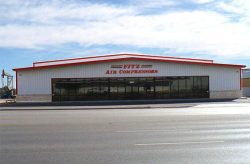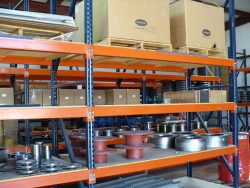What is CFM and How Much Does An Industrial Air Compressor Have?
Air compressors perform a crucial function in any high-powered working environment. They supply much-needed compressed air to fuel a wide array of tools and equipment, such as pneumatic hammers, drilling machines, and shearing equipment. But in order to do this well, you will need to satisfy equipment requirements, starting with the capacity of your air compressor. You may ask yourself: What is CFM in compressor requirement determination? We’ll cover this and more below.
For expert advice or to schedule a service, visit our Contact Us page or call us at 1.888.220.3489.
What is CFM in Compressor Measurements?
Air compressor CFM is an acronym that means cubic feet of air moved per minute. It refers to the volume of air that your air compressor can supply or the amount of air it can discharge per minute at a given pressure level.
The tools and equipment you use are designed to function under specific conditions within any setting. Therefore, in order for them to perform at their full capacity under those conditions, you will need to satisfy their design requirements. And for air-consuming tools, this means being able to supply the required CFM.
In order to do this, you will need to identify the CFM rating of your air compressor to determine whether it is sufficient to power your equipment and whether you can power more than one tool at once. For instance, a high CFM air compressor is capable of delivering more air, making it ideal for industrial applications.
The Difference Between CFM vs. PSI
Now that we’ve answered the question What is CFM in compressor measurements?, we’ll get into PSI (Pounds Per Square Inch). PSI is another important measurement in determining the performance of air compressors. It measures the force of the air that your machine can give off in a given square inch.
In other words, CFM measures the compressor’s airflow, or the amount of air coming out of it, while PSI measures air pressure, or how forceful the air is being blown out of the compressor.
Both PSI and CFM are used as performance specifications for air compressors and have a proportional relationship. In simpler terms, the greater the PSI, the higher the CFM of air supplied from the compressor. These measurements define whether your compressor can meet the demands of your air-consuming equipment.
How Many CFM Should an Industrial Air Compressor Have?
Generally speaking, most industrial air compressors are rated to have outputs of 185 CFM, although many others can easily have higher CFM ratings. Suppose you’re planning to buy an air compressor for your industrial applications. In that case, one of the most significant considerations you have to make is whether your compressor is powerful enough to run your equipment.
In order to determine this, you first have to consider the CFM rating of each of your equipment pieces. We’ve compiled a list of some of the most commonly used pneumatic tools in industrial settings and their corresponding CFM requirements.
- Impact Wrench: 8 – 102
- Ratchet: 10 – 24
- Drilling Machine: 13 – 44
- Angle Grinder: 16 – 76
- Vertical Grinder: 50 – 93
- Air Hammer: 7 – 30
- Engraving Pen: 1 – 5
- Clay Digger: 36 – 47
- Pavement Breaker: 48 – 52
- Orbital Sander: 14 – 22
- Polishing Sander: 22 – 39
The values provided above are based on the typical way these tools are used. For continuous usage of the equipment, you will need significantly higher air compressor CFM capabilities than those that are used for only a few seconds at a time.
To find the minimum required CFM of your compressor to fuel these tools, you will need to multiply its CFM requirements by 1.5. This is because you would want to use a compressor that is capable of producing a higher output and not just the bare minimum to make your equipment work. For example, if you want to find the minimum required CFM for a clay digger with a 36 CFM rating:
Min CFM = (36)(1.5) = 54 CFM
This formula only determines the minimum CFM requirement for a single piece of equipment. If you’re planning on running multiple tools with a single compressor, you will need to add together all the minimum CFM requirements for each device. For instance, if you’re planning to use a drill, ratchet, and vertical grinder at the same time (assuming continuous use):
Drill = (13)(1.5) = 19.5
Ratchet = (10)(1.5) = 15
Vertical Grinder = (50)(1.5) = 75
Total CFM = 19.5 + 15 + 75 = 109.5
Based on our example above, you will need a high CFM air compressor with a minimum rating of 109.5.
Eliminate the Guesswork With Fitz Equipment
During the selection process of your air compressor, understanding the individual requirements of your equipment goes a long way towards choosing an air compressor capable of supplying those needs. Leave out the guesswork and be absolutely sure that your compressor can support your operations even at peak periods of production with Fitz Equipment. Contact us here for assistance, we will help you choose an air compressor that is best suited to your needs.




